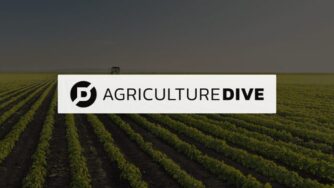Read the full article in GreenBiz
Regenerative agriculture is one of the biggest farming trends of the day; and running alongside that trend are carbon markets. These markets are systems for buying and selling carbon credits that represent greenhouse gas reductions and removals. The reductions and removals are realized by these emerging sustainable agriculture practices that sequester carbon in soil, mitigating its release to, and impact on, our atmosphere.
The concept of turning carbon into a tradable asset is catching attention across the whole food supply chain, especially as policies and regulations are advanced that fight climate change and decarbonize the global economy. On one end are consumer packaged goods (CPG) companies and other enterprises challenged to offset their Scope 3 greenhouse gas emissions (GHG). These emissions occur outside of their operations but within their supply chain. The idea is that, by purchasing credits, companies compensate for their emissions and offset their carbon footprint.
On the other end of the chain are farmers contemplating adopting new, more sustainable land management practices in exchange for revenue generated by carbon offsets and insets — carbon credits. However, it can take multiple seasons before farmers see the soil health and financial benefits of these practices. For them, the hopeful promise of carbon markets, besides additional income, is a way to transition to techniques that are proven to improve their soil, boost profitability and increase productivity.
Credits for reducing greenhouse gases and removing carbon sounds like a win-win for growers wanting to improve how they work and their outcomes, and CPGs with lofty ESG goals. But there are reasons to pause, at least today.
A big challenge is market uncertainty. For farmers, without upfront funds, adopting these new, capital-intensive land management practices can be highly risky. And before buyers jump in, they need to know that this asset truly exists, reduces carbon and will be there in the future. Proving this is harder than we expected within a complex agriculture system for many reasons, which CIBO is working to address.
The challenge is what happens in the environment is ever-changing, dependent on soil conditions and current and historical weather and land management practices, among other variables. So, it’s difficult to predict how much carbon or water will be in the soil over the long term.
Today, knowledge of field conditions is not readily and broadly accessible because there are no large-scale, established sampling and measurement protocols. As a result, accurate, detailed soil carbon data is sorely lacking, and you can’t pay out for what you can’t quantify with precision.
We need good data and transparent reporting. We also need to make sure farmers, CPGs and other entities have access to technical support and other resources to make their investments in carbon markets pencil out.
We are working on this at CIBO, because we see carbon offsets as a means to an end. That end is broad-scale adoption of land management practices that will bring long-term sustainability to our agriculture systems without damaging our environment.
CIBO is a technology platform that provides detailed measurement, reporting and verification of farming practices occurring on the ground using satellite imagery, modeling and cloud computing.
The science-based modeling helps better understand carbon footprint by quantifying the impact of emissions. The platform calculates the emission reduction and carbon sequestration that would be produced by a regenerative agriculture practice, such as planting cover crops or no-till farming. And it determines the return on investment for carbon credits.
To really tell a crop’s carbon footprint story, we have to capture information at a granular level. It’s how we can tell enterprises just where their Scope 3 emissions come from. However, these important details are typically inaccessible in a complex, decentralized system. With many ag businesses operating independently, there’s limited to no way for enterprises to trace activities and outcomes back to one farm along their supply chain.
So, we designed the CIBO platform to monitor activity that affects carbon and measure outcomes at the farm level and across supply sheds. We can trace and quantify emissions from individual fields and compare the carbon footprint of a given farmer’s grain to another’s.
Technology and quality, credible data are important, but advancing sustainable agriculture over the long term needs to be about more. It’s bringing growers access to the capital they need so we can scale adoption of these evolving regenerative practices. That’s how we will work toward climate resilience and meet the growing demand of companies with carbon-neutrality and ESG goals.
CIBO works toward these goals by connecting farmers and end buyers of carbon credits — the CPGs and other enterprises that benefit from emission reductions.
We do this through our platform, which connects growers with incentive programs for adopting new practices (such as programs sponsored by CPGs), making it easy for growers to determine eligibility and enroll. The platform quantifies and verifies the program’s outcome; and it enables growers to generate and monetize carbon credits.
We are taking this work further through a sponsorship program that we call CIBO Carbon Bridge. CPGs and other agricultural enterprises will provide growers upfront capital to transition to cover cropping and no-till; and these sponsors will co-own rights to the resulting carbon credits, which will later transfer to the farmer. The credits will be on the Verra registry. Verra is a robust global standard for certifying carbon emission reductions, and we go through this program so enterprises feel confident that our modeling and verification are vetted by a credentialed third party, and the credit claims are valid.
We secured our first corporate sponsors and are enrolling growers who will plant over 25,000 acres in the spring. After this initiative, we will connect growers to similar incentive programs to be funded by some of our sponsors.
The bottom line: We want to unlock the true power of regenerative agriculture. First, we need to get enough growers to make the transition to these management practices. It takes upfront capital and ongoing incentives. It takes good data, technology and other technical support. And we need strong partnerships between growers and companies with Scope 3 emission goals.
CIBO is bringing all of these pieces together so we can collectively reach our climate goals. At the heart of it is scaling carbon farming and emission abatement as a cash commodity.



